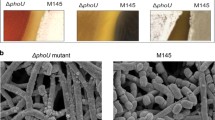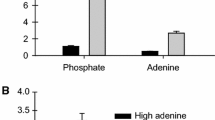Summary
Expression of the repressible acid phosphatase (rAPase) gene, PHO5, of Saccharomyces cerevisiae is repressed by a certain level of inorganic phosphate (Pi) in the medium and is derepressed when the Pi concentration is lowered. The Pi signals are conveyed to PHO5 by a regulatory system consisting of proteins coded for by the PHO2, PHO4, PHO80 and PHO81 genes. We have found that the transcription of PHO81 is regulated by Pi through the PHO regulatory system. Increasing the dosage of PHO4 and PHO81 by ligating each gene to YEP13 gives rise to, respectively, considerable and weak synthesis of rAPase by cultivation of the transformants in high-Pi medium; but in low-Pi medium, increased dosage of PHO4 stimulates the rAPase synthesis significantly, whereas PHO81 has no effect. Increased dosage of PHO2 stimulates rAPase synthesis considerably in low-Pi but not in high-Pi. A coordinate increase of PHO80 cancels the dosage effect of PHO4, but not that of PHO81. Coordinate increases of PHO80 and PHO2 give rise to the same phenotype as an increased dosage of PHO80 alone. The level of the PHO4 protein was found to be the limiting factor of the rAPase synthesis and the copy number of the PHO5 gene not to be. These facts accord with the idea that the PHO80 protein transmits the Pi signals to the PHO5 gene via the PHO4 protein, whereas the PHO2 protein does not have a direct function in the signal transmission.
Similar content being viewed by others
References
Arima K, Oshima T, Kubota I, Nakamura N, Mizunaga T, Toh-e A (1983) The nucleotide sequence of the yeast PHO5 gene: a putative precursor of repressible acid phosphatase contains a signal peptide. Nucleic Acids Res 11:1657–1672
Arndt K, Styles C, Fink GR (1987) Multiple global regulators control HIS4 transcription in yeast Science 237:874–880
Broach JR, Strathern JN, Hicks JB (1979) Transformation in yeast: development of a hybrid cloning vector and isolation of the CAN1 gene. Gene 8:121–133
Buchman AR, Kimmerly WJ, Rine J, Kornberg RD (1988) Two DNA-binding factors recognize specific sequences at silencers, upstream activating sequences, autonomously replicating sequences, and telomeres in Saccharomyces cerevisiae. Mol Cell Biol 8:210–225
Casadaban MJ, Mortinez-Arias A, Shapira SK, Chou J (1983) β-Galactosidase gene fusions for analyzing gene expression in Escherichia coli and yeast. Methods Enzymol 100:293–308
Clarke L, Carbon J (1978) Functional expression of cloned yeast DNA in Escherichia coli: specific complementation of arginosuccinate lyase (argH) mutations. J Mol Biol 120:517–532
Jayaram M, Sutton A, Broach JR (1985) Properties of REP3: a cis-acting locus required for stable propagation of the Saccharomyces cerevisiae plasmid 2 μm circle. Mol Cell Biol 5:2466–2475
Kaneko Y, Toh-e A, Oshima Y (1982) Identification of the genetic locus for the structural gene and a new regulatory gene for the synthesis of repressible alkaline phosphatase in Saccharomyces cerevisiae. Mol Cell Biol 2:127–137
Kaneko Y, Tamai Y, Toh-e A, Oshima Y (1985) Transcriptional and post-transcriptional control of PHO8 expression by PHO regulatory genes in Saccharomyces cerevisiae. Mol Cell Biol 5:248–252
Kaneko Y, Hayashi N, Toh-e A, Banno I, Oshima Y (1987) Structural characteristics of the PHO8 gene encoding repressible alkaline phosphatase in Saccharomyces cerevisiae. Gene 58:137–148
Kimmerly W, Buchman A, Kornberg R, Rine J (1988) Roles of two DNA-binding factors in replication, segregation and transcriptional repression mediated by a yeast silencer. EMBO J 7:2241–2253
Kramer RA, Andersen N (1980) Isolation of yeast genes with mRNA levels controlled by phosphate concentration. Proc Natl Acad Sci USA 77:6541–6545
Kuribayashi K, Mikata M, Hiraoka O, Miyamoto C, Furuichi Y (1988) A rapid and efficient purification of poly(A)-mRNA by oligo(dT)30-Latex. Nucleic Acids Res 19:61–65
Lemire JM, Willcock T, Halvorson HO, Bostian KA (1985) Regulation of repressible acid phosphatase gene transcription in Saccharomyces cerevisiae. Mol Cell Biol 5:2131–2141
Losson R, Fuchs RPP, Lacroute F (1985) Yeast promoters URA1 and URA3 examples of positive control. J Mol Biol 185:65–81
Oshima Y (1982) Regulatory circuits for gene expression: the metabolism of galactose and of phosphate. In: Strathern JN, Jones EW, Broach JR (eds) The molecular biology of the east Saccharomyces: metabolism and gene expression. Cold Spring Harbor Laboratory Press, Cold Spring Harbor, New York, pp 159–180
Parent SA, Tait-Kamradt AG, LeVitre J, Lifanova O, Bostian KA (1987) Regulation of the phosphatase multigene family of Saccharomyces cerevisiae. In: Torrieni-Gorini A, Silver S, Yagil E, Rothman FG, Wright A (eds) Phosphate metabolism and cellular regulation in microorganisms. American Society for Microbiology, Washington DC, pp 63–70
Philippsen P, Thomas M, Kramer RA, Davis RW (1978) Unique arrangement of coding sequences for 5S, 5.8S, 18S and 25S ribosomal RNA in Saccharomyces cerevisiae as determined by R-loop and hybridization analysis J Mol Biol 123:387–404
Rogers DT, Lemire JM, Bostian KA (1982) Acid phosphatase polypeptides in Saccharomyces cerevisiae are encoded by a differentially regulated multigene family. Proc Natl Acad Sci USA 79:2157–2161
Rose M, Grisufi P, Botstein D (1984) Structure and function of the yeast URA3 gene: expression in Escherichia coli. Gene 29:113–124
Tamai Y, Toh-e A, Oshima Y (1985) Regulation of inorganic phosphate transport systems in Saccharomyces cerevisiae. J Bacteriol 164:964–968
Toh-E A, Shimauchi T (1986) Cloning and sequencing of the PHO80 gene and CEN15 of Saccharomyces cerevisiae. Yeast 2:129–139
Toh-E A, Ueda Y, Kakimoto S, Oshima Y (1973) Isolation and characterization of acid phosphatase mutants in Saccharomyces cerevisiae. J Bacteriol 113:727–738
Toh-e A, Nakamura H, Oshima Y (1976) A gene controlling the synthesis of non specific alkaline phosphatase in Saccharomyces cerevisiae. Biochim Biophys Acta 428:182–192
Yanisch-Perron C, Vieira J, Messing J (1985) Improved M13 phage cloning vectors and host strains: nucleotide sequences of the M13mp18 and pUC19 vectors. Gene 33:103–119
Yoshida K, Kuromitsu Z, Ogawa N, Ogawa K, Oshima Y (1987) Regulatory circuit for phosphatase synthesis in Saccharomyces cerevisiae. In: Torriani-Gorini A, Silver S, Yagil E, Rothman FG, Wright A (eds) Phosphate metabolism and cellular regulation in microorganisms. American Society for Microbiology, Washington DC, pp 49–55
Yoshida K, Kuromitsu Z, Ogawa N, Oshima Y (1989) Mode of expression of the positive regulatory genes PHO2 and PHO4 of the phosphatase regulon in Saccharomyces cerevisiae. Mol Gen Genet 217:31–39
Author information
Authors and Affiliations
Additional information
Communicated by G.R. Fink
Rights and permissions
About this article
Cite this article
Yoshida, K., Ogawa, N. & Oshima, Y. Function of the PHO regulatory genes for repressible acid phosphatase synthesis in Saccharomyces cerevisiae . Mol Gen Genet 217, 40–46 (1989). https://doi.org/10.1007/BF00330940
Received:
Issue Date:
DOI: https://doi.org/10.1007/BF00330940




